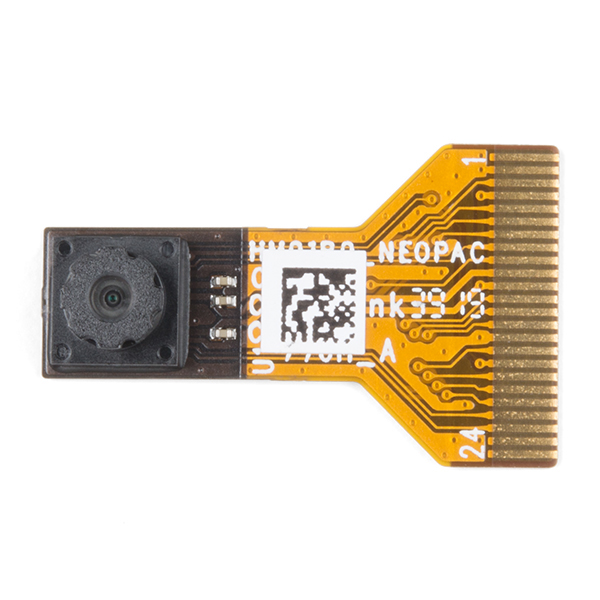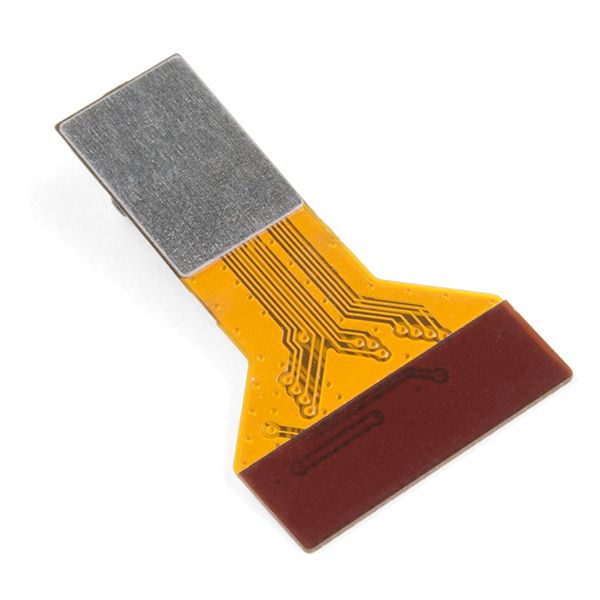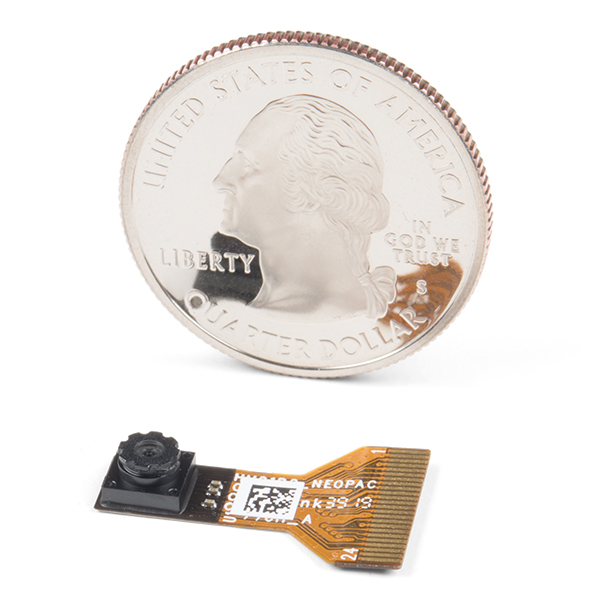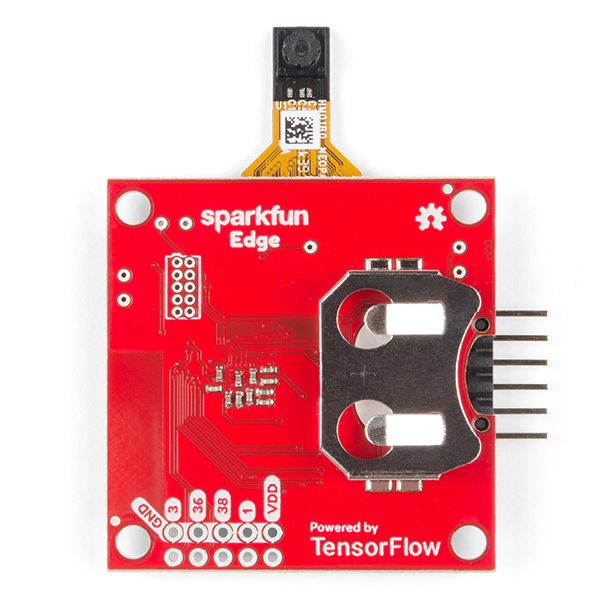The HM01B0 from Himax Imaging is an ultra low power CMOS Monochrome Image Sensor that enables the integration of an “Always On” camera for computer vision applications such as gestures, intelligent ambient light and proximity sensing, tracking and object identification. The sensor allows the sensor to consume very low power of <2mW at QVGA 30FPS. This low power consumption and vision applications camera comes with a ribbon cable that mates to the camera connector populated on the following products:
- MicroMod Machine Learning Carrier Board
- Artemis Development Kit
- Edge Development Board - Apollo3 Blue
The HM01B0 contains 320 x 320 pixel resolution and supports a 320 x 240 window mode which can be readout at a maximum frame rate of 60FPS, and a 2×2 monochrome binning mode with a maximum frame rate of 120FPS. The video data is transferred over a configurable 1bit, 4bit or 8bit interface with support for frame and line synchronization. The sensor integrates black level calibration circuit, automatic exposure and gain control loop, self-oscillator and motion detection circuit with interrupt output to reduce host computation and commands to the sensor to optimize the system power consumption.
Image Sensor
- Ultra Low Power Image Sensor (ULPIS) designed for Always On vision devices and applications
- High sensitivity 3.6µ BrightSenseTM pixel technology
- 320 x 320 active pixel resolution with support for QVGA window, vertical flip and horizontal mirror readout
- Programmable black level calibration target, frame size, frame rate, exposure, analog gain (up to 8x) and digital gain (up to 4x)
- Automatic exposure and gain control loop with support for 50 / 60Hz flicker avoidance
- Flexible 1bit, 4bit and 8bit video data interface with video frame and line sync
- Motion Detection circuit with programmable ROI and detection threshold with digital output to serve as an interrupt
- On-chip self oscillator
- I2C 2-wire serial interface for register access
- High CRA for low profile module design
Sensor Parameters
- Active Pixel Array 320 x 320
- Pixel Size 3.6 µm x 3.6 µm
- Full Image Area 1152 µm x 1152 µm
- Diagonal (Optical Format) 1.63 mm (1/11″)
- Scan Mode: Progressive
- Shutter Type: Electronic Rolling Shutter
- Frame Rate MAX 51 fps @ 320 x 320, 60 fps @ 320 x 240 (QVGA)
- CRA (maximum) 30º
Sensor Specifications
- Supply Voltage: Analog - 2.8 V, Digital - 1.5V (Internal LDO: 1.5V – 2.8V), I/O - 1.5 – 2.8V
- Input Reference Clock: 3 – 50 MHz
- Serial Interface (I2C): 2-wire, 400 KHz max.
- Video Data Interface: 1b, 4b, 8b with frame / line SYNC
- Output Clock Rate MAX: 50 MHz for 1bit, 12.5 MHz for 4bit, 6.25 MHz for 8bit
- Est. Power Consumption (include IO with 5pF load):
- QVGA 60FPS (Typical) <4 mW
- QVGA 30FPS (Typical) <2 mW
- HM01B0 Datasheet (posted with permission)
- Image Sensor Schematic
Himax CMOS Imaging Camera - HM01B0 Product Help and Resources
Programming the SparkFun Edge with Arduino
December 9, 2019
Running low-power machine learning examples on the SparkFun Edge can now be done using the familiar Arduino IDE. In this follow-up to the initial Edge tutorial, we'll look at how to get three examples up and running without the need to learn an entirely new SDK.
SparkFun Edge Hookup Guide
September 26, 2019
Get to know your Edge board, including both the hardware features for you to utilize as well as how to get talking to it.
Getting Started with the Artemis Development Kit
September 10, 2020
This guide covers the general design of the board, the installation of the recommended software used to program the Artemis DK, and some basic examples. For more advanced functionalities, we have separate software development guides for the AmbiqSDK, Arm® Mbed™ OS, and the Arduino IDE platforms that users can reference.
Comments
Looking for answers to technical questions?
We welcome your comments and suggestions below. However, if you are looking for solutions to technical questions please see our Technical Assistance page.
Customer Reviews
3 out of 5
Based on 2 ratings:
1 of 1 found this helpful:
Great little gadget
Great little gadget. Will require you to know how to play with the Edge board.
1 of 3 found this helpful:
No success
I managed to compile the library, but the example python script prints out only ´waiting for first frame 0 1 b'Turned on Edge camera regulator\r\nCamera started successfully\nCalibrating Auto Exposure...\r\n' 2 3 4´
Sorry to hear that you are running into issues with the HM01B0. Consider posting on the forums to get technical support involved: https://forum.sparkfun.com/viewforum.php?f=181






Is a document available that goes into depth about the I2C protocol, the image output format, &c.? The datasheet only mentions these things but leaves a lot of technical questions unanswered. The Arduino library is something, but a good spec would be very useful for folks interested in using this on other platforms...
Is there any info available about the optic part? Lens specs ? AF availability? Thanks
I see that there has been something about connecting this camera to an Arduino - https://github.com/sparkfun/SparkFun_HM01B0_Camera_ArduinoLibrary What setup is used to do that? Is there some kind of adapter hardware?
Despite 'Arduino' being in the name, the library is for the Apollo3 / SparkFun Edge and not for an Arduino type board.
is the datasheet available? I executed the example on the edge board, but the auto exposure didn't converge. In the include"hm01b0_raw8_qvga_8bits_lsb_5fps.h" the shutter time is too long, but not all parametres are so clear.
Is this camera black and white only, or does it have an RGB bayer filter? It doesn't say anywhere in the product description.
I mean, I know it says "Color Filter Array Monochrome and Bayer" under "Sensor Parameters", but that doesn't seem very clear to me. It should be either one or the other.
That parameter was pulled directly from the manufacturer website; you may need to reach out to the manufacturer for further clarification on the color filter array. (I've only seen it working in grey-scale (B/W), but that is probably because we just started testing with the Artemis.)
Would this product be suitable for automated visual inspection? Nothing fancy, just need to recognize fiducials on a PCB.
I'm not an expert in AOI (automated optical inspection), but I don't think that is something we could easily quantify or answer anyways.
For use with other development boards, what is the pitch of the ribbon cable and is it single sided or double sided?
The Sparkfun Edge Dev Board specs the connector as an 'OV7670 camera connector' and on the schematic (https://cdn.sparkfun.com/assets/2/b/7/4/d/SparkFun_Edge_Schematic.pdf) calls out 21 pins (though the OV7670 seems to have just 16 pins), but the HM01B0 ribbon cable is labeled 1-24 pins. Can you provide a pinout for the HM01B0?
What is the field of view for the lens?
The chief ray angle (CRA) has a maximum of 30°.
Just got my camera, the connector is 0.5mm 24 pitch.